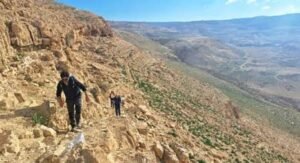The Sacred Trail of Time: Jordan’s 1,600-Year-Old Pilgrimage Path Is Calling.

In a world where ancient paths often fade beneath the weight of time, one trail in the heart of Jordan is rising once more—breathing life into 1,600 years of spiritual footsteps. While Spain’s famed Camino de Santiago has long captured the hearts of wanderers and seekers alike, a resurrected trail in Jordan is quietly claiming its place among the world’s most sacred journeys.
This is the *Jordan Trail of the Early Christians*—a revived pilgrimage route that echoes with the prayers, hopes, and perseverance of early believers who once traveled this land in search of sanctuary, connection, and divine purpose. Hidden beneath layers of history, sand, and silence, this path has now been brought back to life, inviting modern-day pilgrims to walk not only across breathtaking landscapes but through centuries of faith and cultural memory.
Winding for hundreds of kilometers across Jordan’s dramatic terrain, this trail mirrors the historic footsteps of pilgrims heading to the baptismal site of Jesus Christ along the Jordan River—one of the most sacred Christian sites on earth. Starting from the ancient city of Umm Qais in the north and traversing olive groves, hidden caves, Roman ruins, and sweeping deserts, the journey ends at Bethany Beyond the Jordan. This UNESCO World Heritage site is believed by many to be where John the Baptist baptized Jesus—making it a destination as spiritually rich as it is historically significant.

But this is more than just a religious journey. For travelers seeking meaning, healing, or a break from the frantic pulse of modern life, the trail offers an extraordinary opportunity to slow down and reconnect—with nature, with others, and with one’s inner self. Along the way, pilgrims encounter warm local communities, many of whom welcome travelers with meals, stories, and a glimpse into traditions passed down through generations.
Reviving this trail wasn’t easy. A collaborative effort between historians, archaeologists, local communities, and tourism authorities, the project aimed to piece together a path once walked by early Christians—some fleeing persecution, others pursuing a closer relationship with their faith. Now, that path has become accessible once again, not only as a historic journey but as a living one, filled with meaning for today’s seekers.
Unlike the Camino de Santiago, which has become heavily trafficked over the years, Jordan’s sacred trail remains largely untouched by mass tourism. Its quiet majesty offers something profoundly rare: a sense of walking through history that is still raw, sacred, and undiscovered.
Whether you walk the entire trail or just a portion, the experience promises more than just stunning scenery—it offers transformation. As your feet touch the same earth that carried pilgrims centuries ago, you may find yourself reflecting on life’s biggest questions, or simply appreciating the quiet rhythm of step after step, breath after breath.
In Jordan, the past is not a distant memory—it’s a living invitation. The trail is waiting. Will you answer the call?
